Do we really intend to crucify ourselves and our planet? Or will we decide to quickly transform our existing economic system into a highly efficient, flourishing and truly healthy economy?
by Dr. med.Michael Sonntag
Seminar of Evolutionary Leadership and Economy, Bern, Switzerland. email: m.sonntag@yd1.ch
PART I – THE SELF-CREATED HELPLESSNESS OF HOMO SAPIENS
PART II – LEARNING FROM LIVING SYSTEMS – THE FOUNDATION OF A NEW EVOLUTIONARY ECONOMIC PARADIGM
PART III – DECIDE!
* This paper is an edited and abridge version of the article: “The Biological Foundation of an Evolutionary Economy and its Implications for Organizational Culture and Leadership – A new Framework for Strategic Decision-Making”, published in Springer’s Series on Sustainable Finance / Positive Impact Investing © Springer International Publishing AG, part of Springer Nature 2018. K.Wendt (ed.), Positive Impact Investing, Sustainable Finance. https://doi.org/10.1007/978-3-319-10118-7_12
Abstract
This paper presents the essentials of a whole new understanding of a healthy evolutionary economy based on the biological principles of living systems. We will learn from quantum physics and modern biology how living systems manage to proactively and sustainably co-create a maximum of shared value for all involved stakeholders, with a minimum of energy invested, while expanding their evolvability through the constant generation of diversity, novelty and complexity. This First Law of Evolutionary Systems is the foundation of a radically new economic paradigm. Furthermore, we will see how living systems operationalize this final purpose into a coherent set of five Generic Principles.
This will provide the framework for the radical strategic decisions that need to be taken to safety and quickly transform our existing economic system into a highly efficient, flourishing and truly healthy economy. For further background and cases on evolutionary transformation and leadership, see the articles mentioned in the bibliography or contact me directly.
PART I
THE SELF-CREATED HELPLESSNESS OF HOMO SAPIENS
1.The (global) challenge
What level of understanding of the past do we need for the future? Generally speaking, we would all agree that it is of utmost importance to understand the causes of what went wrong in the past, so as to learn from mistakes and avoid them in the future.
However, what happens when we realize that our past concepts were built on incorrect assumptions? What is to be done when we realize that it is not enough to make a few changes, but we must rethink and rebuild our entire system? How do proceed when we realize that radical change occurs far beyond controllable processes?
Learning from nature, we know that living systems operate on the “edge of chaos” and are extremely dependent on the boundaries created. Scientifically there is no doubt: the new only comes into being when we create the right conditions. To decisively and actively create said conditions we must first have a thorough understanding of which principles healthy systems are built upon and what a consistently healthy economy would look like.
Defining these salutogenetic principles of a sustainably healthy, highly efficient and flourishing, even self-healing economic system, and describing them in a rather condensed way, is the aim of this paper. This is what I call, ”The foundation and principles of a new evolutionary paradigm based on the theory of living systems” (Sonntag 2017); or in our context: ”The biological principles of a healthy economy”.
Understanding, redefining and implementing these new principles for a healthy, evolutionary economy is the global challenge we face today. I am afraid that the consequences of the Covid-19 pandemic were only a minor, initial learning step.
In accordance with Douglas McGregor (1960), I also believe, that “possibilities are not recognized, innovating efforts are not undertaken, until theoretical conceptions lay the groundwork for them”.
2. Diagnosis first
As mentioned above, you could seriously argue that analyzing the past will not help us build the future needed; nevertheless, it is worth taking a quick look back – hopefully without turning to stone.
Last century’s assumptions
There have been persistent calls in recent decades to radically rethink our scientific assumptions in order to prevent future economic, social and ecological disaster. This call comes from a broad range of global economic, ecological, political and scientific thought leaders.
Our current economic and management teaching, along with our consulting practices, are still based on principles established by Frederick W. Taylor in ‘’The Principles of Scientific Management”, published in 1911. The scientific assumption behind this approach is the conviction that analyzing each individual process in detail enables us to gain control over the whole. By extrapolating the single parts into a binary, if-then algorithm, we would even be able to predict and manipulate the future and our destiny. Seeing where this system of purported control and power has led us should leave us deeply frightened. And though we perhaps are not (yet) frozen to stone, the fact is that we have put our social, environmental and economic systems as well as ourselves under tremendous stress. From neurobiology we know that under chronic stress our brain’s capacity for clear thinking declines dramatically – under stress you regress. This means, under stress we tend to go back to our old assumed proven survival and behavioral patterns. This reinforces the pre-existing sick and dysfunctional practices (Röösli, Sonntag, Kirkpatrick 2015). We then try to reinforce our drive to gain control by denying reality, manipulating information, digitizing, aligning, standardizing, dehumanizing, and through leaning processes and interactions; centralizing organizations and political systems; and by reinforcing and perverting individual and economic competition. This places the entire system on a highly self-destructive treadmill, which leads to organizational burnout, economic and individual depression and often to uncontrollable violence in an attempt to escape this self-created impotence. This exploitative approach has ruptured our entire social, political and economic system and continues to increasingly tear gaps between economy, ecology and society.
Behind this dynamic lies a deep anthropological dilemma: as Homo sapiens we have lost our teeth and also grown quite slow when it comes to running away. We have become helpless as individuals. We have had to find new ways to detect and deal with threats around us. As a species, we learned that we can only survive as a social group and developed a huge social brain, basically enabling us to manage all the complex social interactions in an extremely fast and efficient manner. We learned to survive through cooperation, diversity and long-lasting relationships. These strategies are rooted in the need to accept and creatively deal with existential interdependency. In our Western culture we left this path, as we know, through the split of mind and body introduced by René Descartes; the introduction of pure mathematical principles to philosophy by Isaac Newton; the declaration of the primacy of mankind over nature in the Age of Enlightenment; building upon genetic determinism, competition and survival of the fittest by natural selection (Charles Darwin); and most recently by trusting more in ”data”, algorithms and AI, than in our knowledge, intuition and social competence.
Assuming that we could control the environment, including other human beings, we cherished the illusion of being nearly omnipotent. We no longer needed to grapple with helplessness. However, to gain this sense of control, we had to act as if our environment is based on controllable and closed, non-interacting and non-interdependent systems. We consequently began to manipulate our reality as if we were dealing with closed systems. We built our scientific systems, our culture, our pedagogical approach, our social and political systems and our economic and management theories on this assumption. This dynamic is still ongoing and even dramatically accelerating. Just look at the money and scientific resources still being spent with the aim of learning more details about genetic processes, digitally analyzing human interactions, detecting financial shifts with complicated algorithms, building on the promise of big data or exploring the potential of artificial intelligence and synthetic biology. This is happening even though everyday experience shows us that this does not work – we know that reality is different and that analyzing digital data does not really enable us to predict the future.
The point is that in our (meanwhile global) reductionist-linear mindset we deeply deny the reality of our natural environment. This is fatal. Not only has the reduction of our natural environment to virtually closed systems given us only minimal additional insight, even worse, today we know that every statement we make within a virtually closed system is fundamentally wrong! The reality of living systems is not just ”more than the sum of its parts”, the whole is fundamentally different than the individual parts. And furthermore, in living systems, the ”whole” changes all the time.
We must embrace the fact that adjusting our mechanistic worldview will prove insufficient to truly become a vital and sustainably healthy system – no mechanical duck will ever become alive (nor merely intelligent), even with endless computing capacities. We need a brand-new operating system based on a radically different understanding of our living environment and reality. We must redefine our scientific assumptions completely to accomplish this.
To comfort ourselves: we have been actively and successfully coping with our natural reality for several 100,000 years. We will not have to redesign the species Homo sapiens, but we will have to deeply confront it with its exploitative laziness, some of its omnipotent craziness and guide it out of its self-created helplessness.
PART II
LEARNING FROM LIVING SYSTEMS – THE FOUNDATION OF A NEW EVOLUTIONARY ECONOMIC PARADIGM
3. Towards a new paradigm built on the science of living systems
Let us plunge headlong into the solution and meet the reality of our natural environment.
When we are open to and learn from modern biology and quantum physics, and perceive the given natural reality of our environment, we are confronted with following fundamental features (figure 1):
Unpredictability In living systems, elements interact with one another in non-linear, non-deterministic, non-trivial ways.
Openness In living systems, energy and information flow openly.
Limited resources In living systems, the energy available is limited.
Emergence In living systems, all systems interact actively, undergoing order transformations, while radically new constellations and dynamics emerge.
Dynamical disequilibrium Living systems search for dynamical disequilibrium, with a minimum of stability within a maximum of instability. They continuously and actively maintain their states as far away from thermodynamic equilibration as possible.

(including a drawing of Leonardo Da Vinci, 1510, www.drawingsofleonardo.org)
Not only do business leaders and investors resign themselves to this reality, but scientists are also in danger of giving in when trying to reconcile these facts with traditional, reductionist scientific methods.
Interestingly, the first attempts to rethink the current scientific assumptions arose from the field of physics, where it was found that within each action lies a variational principle that continuously adjusts and changes trajectories towards a final configuration: not all details of physical processes are determined within a given physical condition! This ”least action principle” is seen as the quantum revolution and provides the scientific basis of a non-deterministic type of spontaneity existing in the physical world (Grandpierre et al 2014). It introduces a fundamental uncertainty into the scientific world. Thus, the freedom and spontaneity observed in living systems no longer contradict physics. Nevertheless, a large gap remains open: although this quantum inter-determinism operates on tiny nanoscales, the organism as a whole functions in a non-random manner, synchronizing all spontaneous activity into a coherent action according to biological demands.
According to Grandpierre and Kafatos, living systems use all their biologically governable form of energy or “free energy” to increase the organism’s capacity to do “biologically useful work”. Their ultimate aim is to flourish. Living systems are not only autonomous and spontaneous in continuously adjusting the trajectories of their actions, but they actively and creatively influence their environment with the aim of performing their “biological useful work” in the most efficient way. Grandpierre and Kafatos call this the “greatest action principle” in biology and define it as the “first principle of natural science” (Grandpierre et al 2013).
This brings goal-orientation and purpose (back) into science, a realm from which they have been exiled for the last four centuries.
Hector Sabelli called this the “biotic logic of quantum processes”: processes in living systems involve action, coexisting and interacting opposites, and causal creation of novelty as well as diversity and increased complexity (Sabelli 2013).
When focusing not only on single living organisms, but whole ecosystems, in the acceptance of the fact of existential co-dependency and the knowledge that living systems do continuously and actively influence each other with the aim of maximizing their capacity to cooperatively do biologically useful work, to ultimate serve their common biological purpose to sustainably flourish, we can apply the “greatest action principle” to large systems and organizations:
The ultimate purpose of any sustainably healthy and productive living system is to enhance and utilize all free energy for the sake of the biological purposes of the whole system.
Healthy living systems actively contribute to an evolutionary process, proactively and sustainably co-creating a maximum of shared value for all involved stakeholders with a minimum of energy invested, while expanding their evolvability through continuously generating diversity, novelty and complexity. I defined this as the First Law of Evolutionary Systems (Sonntag 2017).
You may recognize that this greatest action principle of living systems is, in fact, the scientific foundation of any theory of purpose. It provides the scientific foundation of what Aristotle called the “causa finalis”, as well as the ethic, philosophic and economic concepts of “The Common Good”. It can also be seen as the scientific foundation of the Stakeholder Theory (Freeman 2007 & 2010).
Applying the greatest action principle to the economy, we can now define the First Law of an Evolutionary Economy:
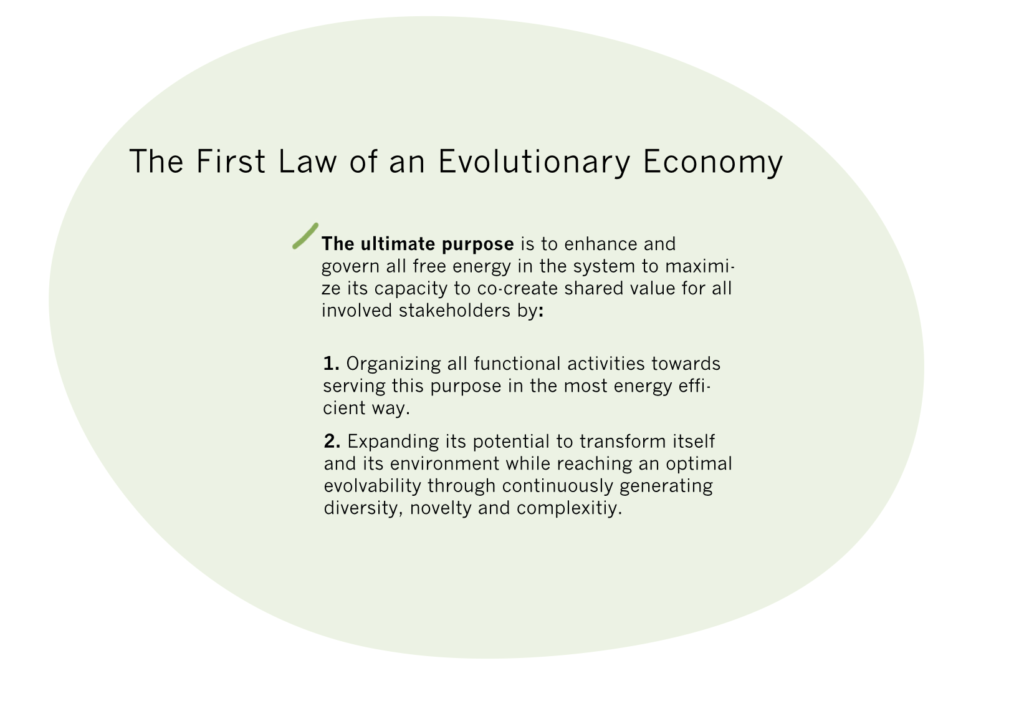
As figure 2 illustrates, depending on your set focus, “all involved stakeholders” includes local, co-local and sometimes global economic and ecosystems, with their social, cultural and governance issues and, of course, local, co-local and global partners and customers.
This is a radically new paradigm based on the biological need of evolutionary cooperation. That is why I call it the “evolutionary paradigm” (Sonntag 2017) and also prefer talking about ”evolutionary systems”.
I view the defined “First Law of an Evolutionary Economy” as the foundation of a radically new economic paradigm enabling us to design the framework and principles of a healthy economy.
Within the evolutionary paradigm, the gap between social, economic and ecologic welfare, which was virtually created by the traditional scientific management and economic models, fades away and eventually closes: the three parts of the first law become the triple future line in proactively and sustainably co-creating shared value and shared wealth. It creates a self-reinforcing, autocatalytic, highly resilient and even self-healing system in which social, economic and ecologic welfare enhance each other (see Sonntag 2020 Routledge).
In the following chapter we will define the generic principles of the new operating system.
4. Designing the operating system of an evolutionary economy
As we have seen, living systems are not only able to survive within the given conditions of our natural reality, but are able to use these conditions proactively and creatively to sustainably boost their free energy to do biological useful work.
The scientific study of evolutionary systems and understanding the principles they follow to achieve this goal enables us to design a radically new set of five operational principles. These five principles are essential, irreducible conditions ”sine qua non”, meaning that they are all interrelated and one cannot be implemented without the others.
That is why I call them “generic principles”. Together, they define what I refer to as the epigenetic code of any living system, able to sustainably maximize the co-creation of shared value with a minimum expenditure of energy, while maintaining optimal evolvability.
Figure 3 shows the generic principles of evolutionary systems. These five generic principles are the scientific foundation of the operating system of an evolutionary economy, as well as the foundation of any healthy, human-built enterprise including companies and organizations.
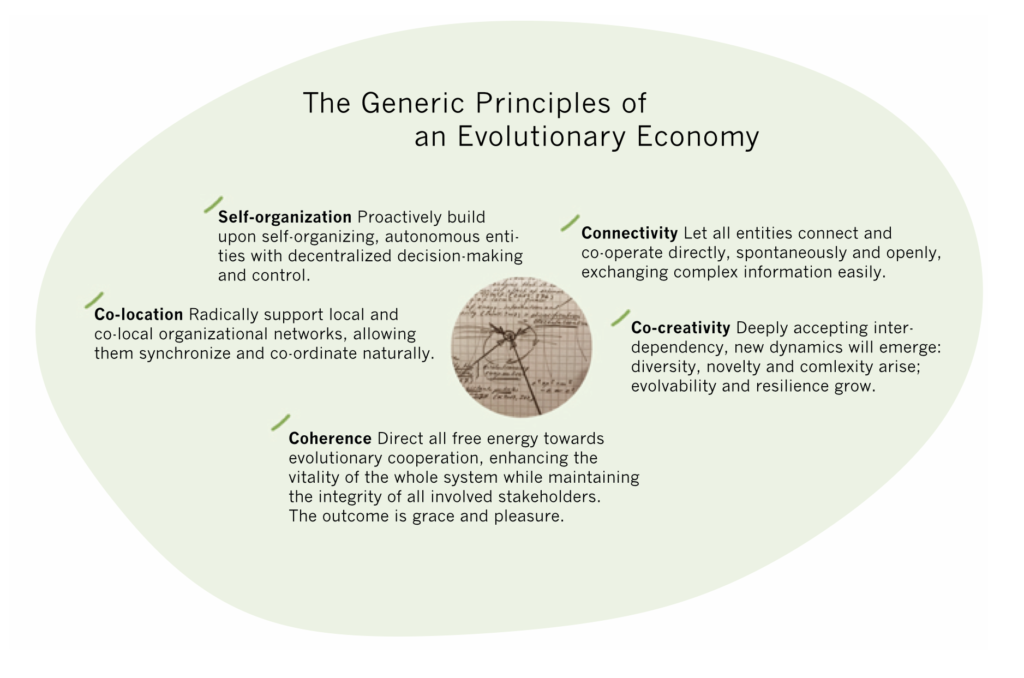
Please read the original Springer article for a detailed description of the five generic principles.
As mentioned, the generic principles of the new operating system are interconnected and interdependent.
Some of the designed generic principles of living systems are already being applied on organizational levels. Good examples include the Swedish Handelsbanken, Morning Star, W.L. Gore, Semco Partners, Valve Software, Buurtzorg and Gangplank (www.whatisgangplank). Corresponding theoretical discussions are ongoing by Gary Hamel (Hamel 2007 & 2012), Stephen Denning (2010), Frederic Laloux (2014), or Jurgen Appelo (2011). A great deal of experience that has already been tested is condensed in the Beyond Budgeting Roundtable, BBRT.org. In their book ”Beyond Budgeting” (2003) Jeremy Hope and Robin Fraser, inspired by the Swedish Handelsbanken case, began developing a new mind-breaking management model based on radical decentralization. Companies involved in the Beyond Budgeting Roundtable developed the concepts and gained a tremendous experience in implementing new management aspects.
All these examples attempt to combine different, more agile and dynamic approaches to management. Integrating them into a coherent theory and understanding of an evolutionary paradigm, based on the science of living systems, will give them the impact to truly begin to change our business world.
It is important to understand that the new operating system designed along the lines of the five generic principles of living systems, as well as the previously mentioned examples on a management or business level, is on a purely technical, operational and process level. Understanding the “greatest action principle”, we know that healthy living systems always follow a very clear und unbiased purpose: to govern all free energy in the system towards maximizing its capacity to co-create shared value for all involved stakeholders. Just implementing a new operating system on a technical and management level is not enough to become sustainably vibrant and healthy. This is the case on an organizational and, even more so, on an economic level. Furthermore, to have a ”higher purpose” as a company without implementing the generic principles on an operational level will ultimately prove to be unsustainable.
Therefore, to follow the First Law of an Evolutionary Economy, the five generic principles need to be framed into two governing principles.
In figure 4, the governing principles of evolutionary systems are defined on the strategic and leadership level:
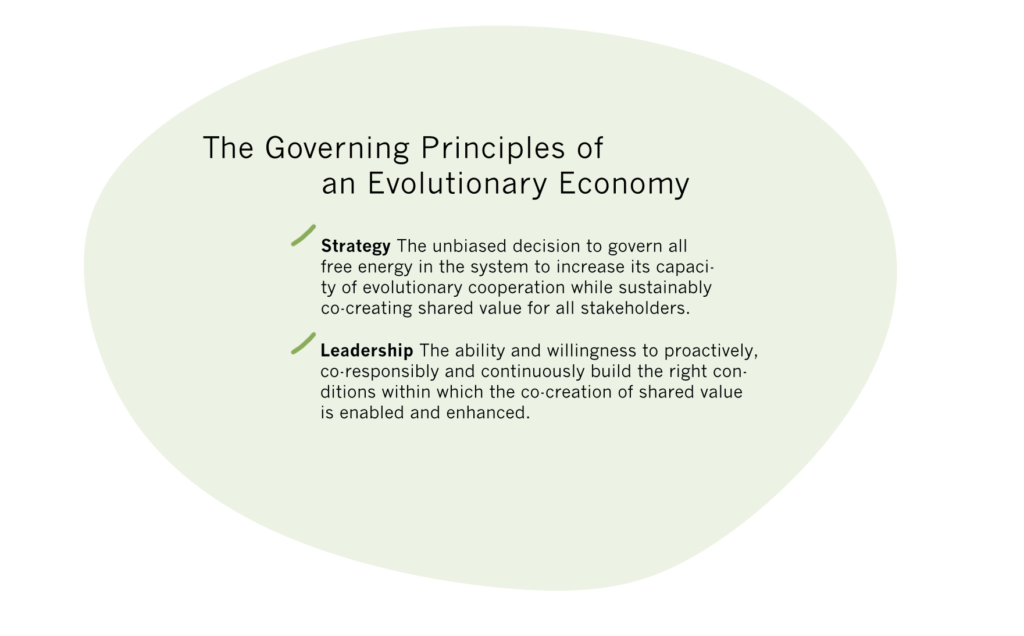
Only when these two governing principles added do we not only have a well-functioning living system, but a sustainably flourishing, self-reinforcing and resilient evolutionary economic system. Without the two governing principles, the whole self-organizing system will fall apart.
At the center of this evolutionary paradigm is the sustainable co-creation of shared value in decentralized, autonomous operational units and engagement platforms in direct contact with their natural environment, stakeholders and customers. We must understand that this interactive, co-creative process in direct contact with the environment is THE locus of any sustainable value creation. This is especially true on business and economic levels (Prahalad & Ramaswamy 2004, Gulati 2010).
Putting this value creating, customer- and stakeholder-centered process at the center of the economic system and business design (Ramaswamy and Gouillart, 2010 & 2010; Freeman 2007 & 2010), it becomes clear that the designed generic principles, together with the two governing principles, form the conditions that enable and optimize this core value-creating process.
Digging even deeper into a synthesis of the necessary framework yields what follows in figure 5: An evolutionary economic system should enable and enhance the sustainable co-creation of ”the common good” (Zermatt Summit Manifesto; Centesimus Annus Pro Pontifice Foundation) in the most efficient way.
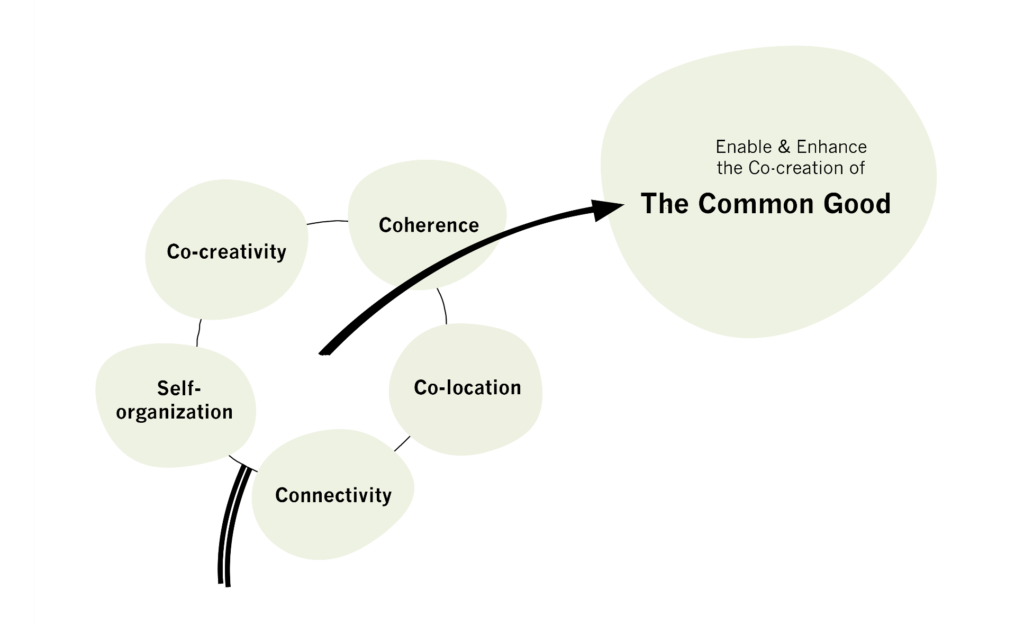
Underneath these governing and generic principles there are deep, archaic emotional and neurobiological systems, which largely unconsciously steer our decisions into coherent, goal-orientated, meaningful, pro-social action. I described them in detail in the original Springer article.
It is fundamentally about positive and negative feelings:
An overall positive emotion occurs when we feel that we are able to govern our limited free energy (and limited lifetime) into sustainably purposeful work with the minimum of energy invested while even opening new opportunities (evolvability).
The aforementioned neurobiological affective systems are the manner we learned as humans to actively manage the interdependency with our complex environment and each other in a very efficient way, while maintaining the integrity of each individual and of our environment. These affective, motivational neurobiological systems enable us to reduce the complexity of cognitive inputs by appropriately regulating the focus of attention and perception, and by channeling our decisions into coherent meaningful action. It is ultimately about our ability to actively maintain our integrity. The overarching feeling that emerges when we are on this path of actively and sustainably maintaining our integrity is a sense of grace and pleasure (Lowen 1966). Any action that does not lead to a feeling of grace and pleasure does not add value to the purpose of sustainably co-creating shared value. This is how the seemingly self-organizing chaos in living systems is governed towards a coherent, purposeful action.
On the other hand, when we are not able to manage our limited energy cooperatively and co-creatively in the described way, we feel helpless and stressed. Our behavior will be dominated by avoidance. The resulting emotions are fear, panic and pain. It ends in a systemic breakdown and depression.
This provides an entirely different view of what we normally would call our gut feelings or what Daniel Kahneman calls “System 1” (Kahneman 2011). In contradiction to Mr. Kahneman, I am convinced that these affective systems are not just unspecific, archaic, rough emotions, which must be controlled by higher brain functions or “System 2”. They are, in fact, detailed information and steering systems that enable us to actively deal with the immense complexity of our natural environment, including social interactions, in a highly specific, efficient and effective way (for more details, please see my original article).
From affective neuroscience and affect logics, we know that these affective motivational systems are much stronger than any behavioral patterns. They effectively steer our cognitive capacity in a certain direction. These affective motivational systems not only overrule cognitive processes, but as scientific facts, they out-rule anything we have learned about cognitive behavioral processes, cognitive neuroscience, learning organizations and behavioral economics. They shift homo economicus and homo algorithmicus (Sonntag 2020 Springer) into the storeroom for good.
PART III
DECIDE!
5. Implication for leadership, organizational culture and the management models
Understanding affective processes as the steering forces of evolutionary systems and stating that grace and pleasure are the most important KPIs, and even when talking about the co-creation of the common good being the core value-creating process, we must keep in mind that this is not about a humanistic approach to business and economics, but the result of a very clear scientific standpoint and framework with the simple aim of increasing the capacity and ability to do biological useful work and to sustainably produce the maximum of shared value with the minimum of energy invested, while expanding the evolvability within the given natural reality. There is absolutely no stochasticity in this process – each step or sub-process is built upon very clear biological and causally-generated creative patterns, deeply embedded in the DNA of every living system. This is fundamentally a very pragmatic and emotionally unbiased approach to economics and business.
The leadership’s responsibility is to create the right conditions to release “the power of co-creation” (Ramaswamy & Gouillart 2010) through enabling and enhancing evolutionary cooperation.
This only works efficiently if the organizational culture and the management model, including all levels – from operations to processes, to organizational culture and transformation processes as well as the governance principles – are fully congruent with the described five generic principles. Otherwise, the free energy will not efficiently flow into the production of shared value, but will be absorbed and destroyed through internal, dysfunctional, complicated, resource-consuming control and micro-management procedures.
6. Decide! A new framework for strategic decision-making
Although nature creates a wide range and variation of evolutionary opportunities, when it comes to applying the generic principles, it is very rigid! The aforementioned neurobiological motivational and affective systems work on an on/off principle: when the right conditions are in place, the system is activated and self-enhancing, or, with a self-protecting purpose, it shuts the energy flow down if the right conditions are missing.
The same is true for strategic decision-making within the evolutionary paradigm: each basic condition must be actively and properly applied – no compromises accepted! Each of the following questions must first be deeply understood and then clearly answered affirmatively. Otherwise, the whole system will fail. No action should ever be taken before all of the following criteria are coherently met.
A new framework for strategic decision-making
Remember: The overall purpose is to enhance the free energy and to govern the energy towards evolutionary cooperation.
First the two governing principles must be met:
- Strategy
Have we decided to govern all free energy so as to increase the capacity of evolutionary cooperation while sustainably co-creating shared value for all stakeholders?
- Leadership
Are we able and willing to proactively, co-responsibly and continuously build the right conditions within which the co-creation of shared value is enabled and enhanced?
The generic principles must then also be applied:
A. Coherence
- A1 Do we base all our decisions and actions on an Y2Y human nature concept (see Sonntag 2018)?
- A2 Are we willing to build our decisions on a stakeholder engagement model (only win-win decisions are accepted)?
- A3 Are we willing to maintain the integrity of all stakeholders even during a crisis?
B. Self-organization
- B1 Are we radically decentralizing decision-making?
- B2 Are we building on diverse, small, agile and autonomous teams?
- B3 Are these teams connecting actively, dynamically and intensively with the stakeholders?
C. Connectivity
- C1 Do our processes enable the perception and active sharing of complex information?
- C2 Are we providing information systems that are open, informal and dynamic, adaptable to a given situation?
- C3 Are we providing direct physical contact with the stakeholders, so as to allow resonance to occur spontaneously?
D. Co-location
- D1 Are we thoroughly building a decentralized network organizational structure with co-locally and autonomously acting operational units and engagement platforms?
- D2 Are we using and actively co-creating co-local, easily scalable synergies?
- D3 Do we aim for growth in diversity, novelty and complexity
E. Co-creativity
- E1 Are we willing to build our interactions on mutual interdependency?
- E2 Are we willing to let everyone become strongly engaged and to develop long-term relationships built on empathy and concern?
- E3 Are we conscious and willing to accept that any co-creative process can involve transformational dynamics in which both interacting parts, including ourselves, can go through transitions?
Exactly the same decision-making framework is applied in everyday operational decisions and all decisions throughout the value chain of business activities.
It may appear to be a simplification to repeat the same principles on every level. However, there is an underlying biological code: this recursive pattern creates a highly energy-efficient, fractal structure which quickly enables scaling processes without any central control and with the investment of a minimum of energy. Today we know that most biological processes are based on such fractal, recursive patterns.
One could argue that the described decision-making process is much too complicated and slow. In fact, this is not the case. We undergo this procedure on an unconscious level constantly in any everyday action. On a largely unconscious level, we all always try to optimize our energy and continuously adjust the trajectories to decide which action will have the greatest impact with the least energy invested while expanding our options to act (greatest action principle & 1st law of evolutionary systems). Any action that will inhibit us in our autonomy or will cost too much energy will give us a bad ”gut” feeling and will therefore unconsciously drive us to find better solutions. If this is not possible at the moment, we will decide to take some time to think (or sleep), get more information, try to deepen the relationship with concerned stakeholders, or get help or advice from our peers or elders. This is the healthiest and most efficient way to move forward, creating a maximum of shared value and to flourish sustainably within the given complexity of our natural environment and social interdependencies. As we have seen, we as human beings have acquired the capacity to deal with our complex, continuously changing environment including all (often very) complex social interactions in an extremely quick and efficient way. By using our affective capacity, we have the possibility to quickly decide if something feels right or not. This information processing capacity in humans has been calculated by Grandpierre et al (2013) to be as huge as 1022 bits/second. This “organismal unconsciousness” is defined as the number of decisions made at the cellular and supra-organismal level (e.g. including collective unconsciousness). Our normal mental, conscious processing capacity is about 100 bits/ second or less. This includes the slower cognitive decision-making parts that were described by Kahneman (2011). They indeed are slow and not really helpful in daily business.
But again: this process of quick and highly integrative continuous decision-making within a complex environment works only efficiently and sustainably if the right conditions have been established in the organizational culture and management system. These conditions must be created actively on a strategic level.
This new comprehensive framework for strategic decision-making, based on the study of living systems, neuroscience, quantum physics and modern biology will enable us to move proactively and strongly into the future. It enables us to leave the strategic world as we know it, with its very limited and in fact incorrect understanding of competitive advantage, behind us and to safely and quickly start building a highly efficient, flourishing and truly healthy economy.
To apply the evolutionary paradigm to transform our current economic system we indeed do not need much understanding of the past – we can start here and now – “Working from the Future backward” (Hamel 2007).
To reach this goal, we must become brutally strategic.
Bibliography
For more scientific background and a detailed bibliography, please see the original Springer article or contact Dr. Sonntag.
Other articles available:
About the basic principles of evolutionary living systems
Sonntag, M. (2017). Flow with Purpose. The Foundation and Principles of a New Evolutionary. Paradigm, including the GAAIB case: Prototyping towards a New Paradigm in Health Care. COS Journal, 6(2)
Open source & free download
www.cos-collective.com/cos-journal/2017-volume-6-issue-2
About the 1st Law of an Evolutionary Economy and the implications for Positive Impact Investing
Sonntag, M. (2018). The Biological Foundation of an Evolutionary Economy and its Implications for Organizational Culture and Leadership – A new Framework for Strategic Decision-Making. Springer’s Series on Sustainable Finance / K. Wendt (ed.), Positive Impact Investing
https://link.springer.com/chapter/10.1007/978-3-319-10118-7_12
About a new paradigm of transformation and implications for evolutionary investment
Sonntag, M., Mesesan, C., Lau, A. (2020). God doesn’t gamble – Evolutionary investment and Leadership as Agents for Rapid Transformation, including the Iroquois Valley Farmland REIT, PBS Case. Routledge. Social and Green Economy Finance (in print)
About transformation in living systems. A new concept of direct, fast and safe transformation
Sonntag, M. (2020). Y.1 – The Biological Code for Evolutionary Transformation and Strategic Investment Decisions. Including the Svenska Handelsbanken Transformation Case: The Blueprint for a new Paradigm of Change. Springer’s Series on Sustainable Finance / K. Wendt (ed.), Theories of Change (in print)
The Svenska Handelsbanken Transformation Case can be accessed on my LinkedIn Profile.


